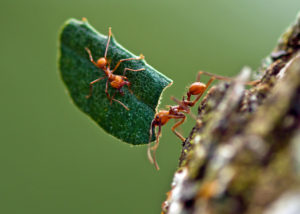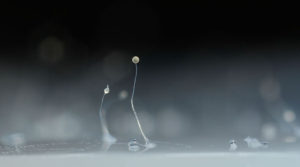Think of a farmer. Chances are, an image of an overall-wearing, pitchfork-wielding man just popped into your head. But humans are only one of a surprisingly large group of animals that cultivate their own food.
You might already know about leaf-cutter ants–some 47 species of ants in the New World that meticulously cut fresh vegetation into fragments that look far too big for them to hold. But they somehow manage to carry those leaf and flower cuttings back to their nests. This plant material is then used to feed the fungus that these ants depend on for food. Just like human farmers, the ants regularly plant, cultivate, and harvest their crop. However, rather than wheat or soybeans, the crop is a specific species of fungus. In fact, the relationship between the ant farmers and fungus is so complete that neither can survive without the other: the fungus can no longer propagate itself without help from the ants, and the ants need the fungus for nutrition. Leaf-cutter ants are an extreme group of farming ants because they are so dependent on their fungal crop for survival, but about 240 ant species (collectively known as the attine ants) practice some form of fungus farming.

Farming isn’t limited to ants: some species of termites and ambrosia beetles (a type of weevil) are also known to grow fungus for food. These groups demonstrate some of what we think of as the most ‘advanced’ farming. They’re ‘advanced’ because they have evolved many adaptations specific to farming, such as specialized organs or behaviors, and they often can’t survive without farming. Because of this, and because scientists have long-known about the farming practices of these animals, these three groups are the most heavily studied non-human farmers. But focusing on just ants, termites, and beetles overlooks the fact that farming is likely evolutionarily beneficial for many organisms: when food is in short supply, being able to generate your own can be life saving.
Unsurprisingly then, once scientists started looking for evidence of farming in different organisms, they found it in snails, amoebas, and fish, among others. For example, the dusky farmerfish cultivates a specific species of algae. They do so in little ‘gardens,’ which they aggressively defend from other fish. When the farmerfish are experimentally removed from their gardens, all the algae is quickly eaten by other fish. The algae don’t seem to grow outside of these gardens, and the fish rely on this algae as a staple food, making this another relationship where both players need each other to survive.
But not all farming works this way: a different type of farming relationship was described in 2011 between an amoeba and a bacterium. The social amoeba, Dictyostelium discoideum, lives as single-celled organisms that spend their time eating bacteria. When environmental conditions get tough, the individual cells aggregate to form a ‘slug’ that crawls elsewhere more rapidly than the individual amoeba cells could have. Once in a better environment, the slug changes shape again. This time, it turns into a stalked fruiting body that releases spores. Each spore becomes a new single-celled amoeba. Some strains of this amoeba farm their bacteria: instead of eating all the available bacteria, they take some up and incorporate them into their fruiting bodies. When spores are released, the new amoebas are already carrying the bacteria with them, which they then use to seed their new environment with food–just like humans sowing their fields.

Not all Dictyostelium discoideum individuals demonstrate this farming behavior, which suggests that there could be downsides to farming. In this case, farming may be disadvantageous if the amoebas find themselves in a new environment that is already full of food. If this happens, the farming amoebas would have paid a cost by not eating all of the available food (and growing and reproducing) in their prior environment. In comparison, the non-farming amoebas wouldn’t have paid this same cost because they always eat all the food available to them. Because research on non-human farming has often focused on species that must farm to survive, the costly aspects of this behavior have not been extensively considered.
As scientists continue to explore the diversity of life on Earth, finding and characterizing new farming relationships can continue to give us insight into what this unique behavior can look like, and how it might vary in its evolution.
Additional readings:
Ants, termites, beetles: Mueller et al. 2005. The evolution of agriculture in insects. Annual Review of Ecology, Evolution, and Systematics 36:563-95.
Fish and algae: Hata H, Koto M. 2006. A novel obligate cultivation mutualism between damselfish and Polysiphonia algae. Biology Letters 2:593-6.
Amoebas: Brock et al. 2011. Primitive agriculture in a social amoeba. Nature 469:393-8. Brock et al. 2013. Social amoeba farmers carry defensive symbionts to protect and privatize their crops. Nature Communications 4:2385.
Peer edited by Paige Bommarito.
Follow us on social media and never miss an article: